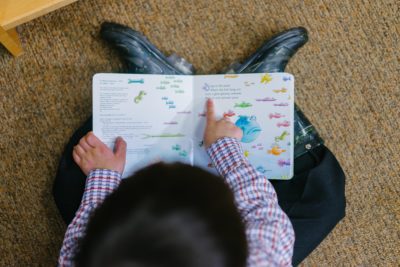
North Carolina’s 115 public school districts were able to choose which platforms they use to measure early readers’ progress for this school year.
Here are the ones they decided to use in their K-3 classrooms, according to the Department of Public Instruction. The Innovative School District (ISD) is not included in the map but is using NWEA’s MAP tool.
Diagnostic assessments in the early grades are required by Read to Achieve, a legislative initiative aimed at improving reading proficiency. In 2018-19, 57% of third-graders scored proficiently on end-of-grade reading tests; go here to find the proficiency rates by district.
The Read to Achieve (RTA) law requires the State Board of Education to provide districts “with valid, reliable, formative, and diagnostic reading assessments” to test K-3 students. The state usually chooses and funds a single assessment platform.
But for this year, the board approved five vendors that districts can choose from, listed in the chart below, which was sent to EdNC by DPI spokesperson Graham Wilson. He said districts and charter schools have been allotted funds based on their average daily membership, and are responsible for contacting the vendor of their choice.

Here’s the district choice breakdown, with each vendor’s percentage of the student population:

A list of 14 recommended local alternative assessments (which districts must fund themselves) for this school year was released Tuesday. These give students who do not score proficiently at the end of third grade a different testing option. Districts must submit which alternative assessments they will use by the beginning of December.
Teachers in the state’s K-3 classrooms used mCLASS tools owned by Amplify in recent years to monitor student reading.
When Superintendent of Public Instruction Mark Johnson announced the state was switching to contract with Istation in June 2018, many teachers expressed concerns with changing platforms. Amplify filed a protest, claiming that the procurement process was unfair and that Johnson had tried to influence the evaluation committee’s process. A stay was put on the contract while the state Department of Information Technology (DIT) reviewed the protest. A hearing took place in January.
Without a DIT decision, Johnson canceled the Istation contract in April and announced in May that districts would choose their own platforms, going into a school year filled with uncertainty amid the coronavirus pandemic. DIT officially canceled the case in June.
Johnson released the breakdown of the districts’ choices by percentages of the student population last week.
“I am pleased to report today that based on conversations I have had with other leaders, the nation is watching North Carolina with excitement because we have innovated in a way that others want to emulate,” Johnson said in a news release. “I want to express my gratitude to the team at DPI who helped bring into action our idea of being able to use multiple K-3 reading diagnostics across the state for the Read to Achieve program.”
Board Vice Chair Alan Duncan said at July’s meeting that districts will sign one-year contracts with the assessment companies “while we go through a more detailed procurement process to culminate in a lengthier contract with most likely one vendor based on the previous legislation, but that’s all to be discussed.”
Wilson said districts should consider coronavirus safety measures when choosing a platform.
Guidance from the state Department of Health and Human Services “requires at all times in a classroom: both (i) six feet of distance between a student and a teacher and (ii) face coverings worn by students,” Wilson said in an email. “In addition to remote learning use, districts should keep these requirements in mind when selecting the most practical tools for this school year.”
A larger reading effort, a newly approved plan
The assessment platform teachers use to measure reading is just one part of a complex puzzle of ensuring children learn to read by the end of third grade, a metric that research has linked to future academic success and high school graduation.
Read to Achieve has directed more than $150 million to improve third-grade reading proficiency. A 2018 study by the Friday Institute for Educational Innovation found the program to have no impact on reading proficiency.
The State Board of Education adopted a Collaborative Guiding Framework for Action on Early Reading in 2019 that outlined nine priority actions for the state. “NCDPI is developing action steps for each of the priorities, including new or revised SBE policies, NCDPI initiatives using existing resources, and legislative recommendations, including both recommended statutory revisions and appropriations requests,” the department said.
A state board literacy task force released recommendations this summer, which the board adopted, on how the state could improve literacy instruction — from how new teachers should be prepared, to how districts should choose curriculum, to how current teachers and administrators could be trained in effective strategies.
And just last week, the board adopted a Comprehensive Plan for Reading Achievement, a 105-page document required by Read to Achieve to improve reading achievement in public schools. The introduction to the plan says it’s for educators to make informed curriculum choices, design instruction, and “have strategic conversations about students’ reading challenges, progress, and success.”
The plan says DPI will support its implementation in schools by providing professional development, resources on scientific research about teaching students to read, and technical support. The document delves into instruction, assessment, professional learning, and a framework called Multi-Tiered System of Support (MTSS).
The plan will go in front of the Joint Legislative Education Oversight Committee next. JB Buxton, a former state board member who has been outspoken about reading reform, weighed in at last week’s meeting. Buxton has been named as the new president of Durham Technical Community College.
“I think we’ve got a point of view in this report on what we think effective reading instruction looks like, how important high-quality instructional materials are, the role of teacher preparation, the role of support in the classroom,” Buxton said. “… I feel good about what we stand on the brink of being able to achieve as a state.”







